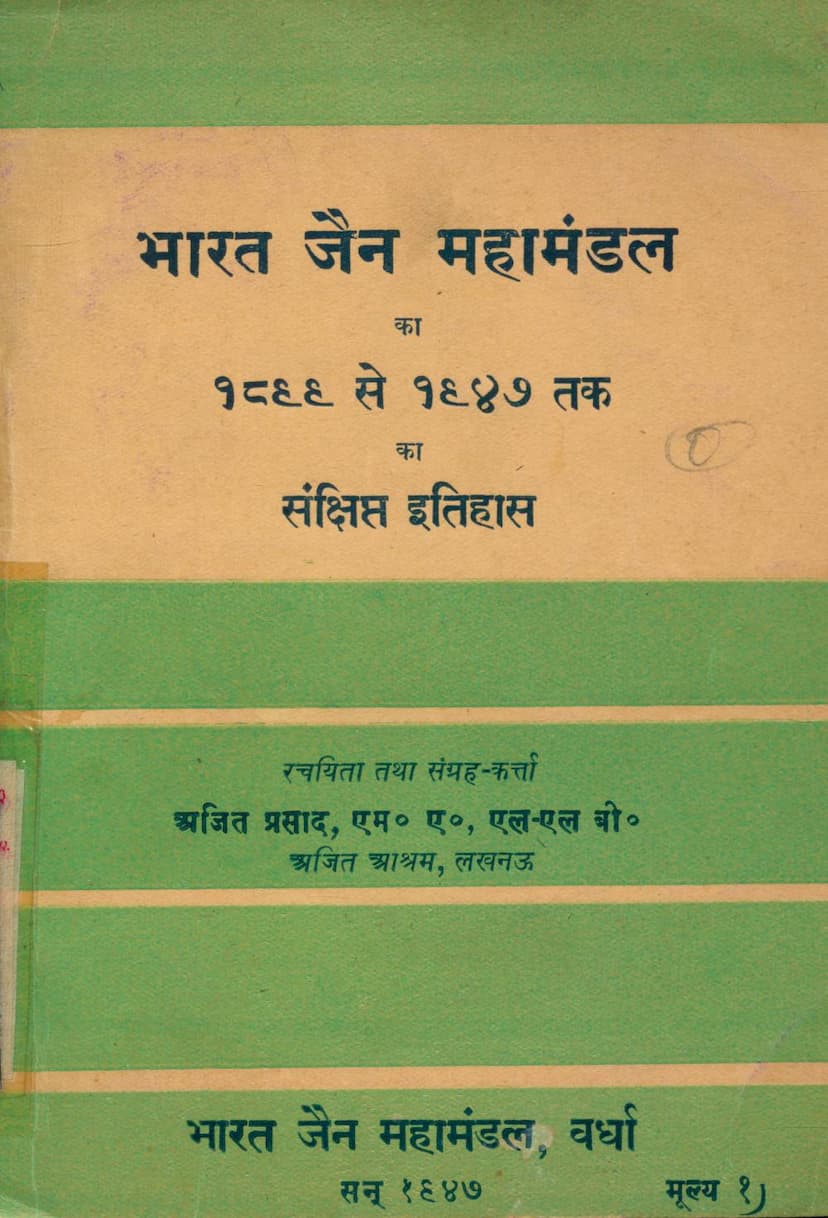Bharat Jain Mahamandal Ka 1899 Se 1947 Tak Ka Sankshipta Itihas
Added to library: September 1, 2025

Summary
Here's a comprehensive summary of the provided Jain text, "Bharat Jain Mahamandal ka 1899 Se 1947 Tak ka Sankshipta Itihas" (A Concise History of the Bharat Jain Mahamandal from 1899 to 1947) by Ajit Prasad:
This book chronicles the history and activities of the Bharat Jain Mahamandal, an organization dedicated to the progress and unity of the Jain community, from its inception around 1899 up to India's independence in 1947. The author, Ajit Prasad, meticulously documents the various conferences, resolutions, and initiatives undertaken by the Mahamandal over these decades.
Early Origins and Formation: The book begins by noting the surge of national and social consciousness in India following the establishment of the Indian National Congress in 1885. During this period, influential figures like Sir Syed Ahmed Khan and Swami Dayananda Saraswati were active. In 1895, the Digambar Jain Sabha was founded in Mathura. However, due to internal differences and sectarianism, a group of progressive young Jains formed the Jain Youngmen's Association of India in 1899.
Key Objectives of the Association (later Mahamandal): The primary goals of this new organization were:
- To foster mutual unity and cooperation among all Jains.
- To promote social reform within the Jain community and awaken an interest in Jain principles and practices.
- To encourage the study of religious texts alongside English education.
- To assist Jain youth in establishing themselves in trade and business with the help of influential individuals.
Evolution and Key Activities: The text details the progression of the organization through its various annual conventions (Adhivevans). Each convention marked significant developments:
-
Early Conventions (1899-1902): The initial phase focused on establishing organizational structure, electing office bearers, and setting foundational goals. The establishment of a Jain Orphanage in Meerut was a key early achievement. Resolutions were passed regarding universal membership regardless of language proficiency, the publication of a Hindi Jain Gazette, creating a list of educated Jains, simplifying Jain principles for the public, and advocating for separate enumeration of Jains in government census. The Jain History Society was also formed.
-
Expansion and New Initiatives (1902-1907): This period saw the establishment of provincial branches across India (Punjab, Bengal, UP, Madras, Rajputana, CP, Bombay). Initiatives like the "Manbhavati Devi" gold medal for Sanskrit scholars and the "Bachhulal" medal were introduced. A "Widow Support Fund" was established. The organization also focused on establishing institutions like the Jain Siddhant Bhavan in Ara and the Syadvada Mahavidyalaya in Banaras.
-
Addressing Social Reforms and Unity (1907-1915): Major themes during this era included:
- Inter-community Harmony: A strong emphasis was placed on bridging the divides between the Digambar and Shwetambar sects. Resolutions called for mutual cooperation in social and political matters and the settlement of disputes through committees.
- Social Reforms: The age of marriage for girls and boys was raised. Calls were made for simplicity and economy in social and religious functions, the abolition of wasteful expenses, and the removal of the Purdah system.
- Education: Promoting both secular and religious education, particularly for women, was a consistent focus. There were discussions about establishing educational institutions and providing scholarships.
- Journalism: The "Jain Gazette" (English) played a crucial role as the organization's mouthpiece, with various editors managing it over the years.
-
Challenges and Continued Efforts (1915-1947): The later period saw the organization facing challenges such as the cessation of conferences for extended periods due to legal disputes (like the Sammed Shikharji case) and the involvement of its members in national movements. Despite these hurdles, the Mahamandal continued to advocate for:
- Resolution of Disputes: Persistent efforts were made to resolve disputes related to pilgrimage sites through arbitration and Panchayats, aiming to prevent costly litigation.
- Women's Empowerment: Continued focus on women's education, widow welfare, and empowering women in social and religious spheres.
- Economic and Social Upliftment: Proposals for establishing cooperative banks, promoting vocational training, and addressing unemployment within the community.
- Religious Principles: Reaffirming the core tenets of Jainism like Ahimsa (non-violence), Satya (truth), and Syadvada (non-absolutism), and encouraging their practice in daily life.
- National Integration: Encouraging Jain participation in national movements and supporting the Indian National Congress.
- Institutional Development: The establishment and support of various Jain institutions, including schools, colleges, and libraries.
Key Themes and Recurring Issues: Throughout its history, the Bharat Jain Mahamandal grappled with several persistent issues:
- Sectarianism: The enduring challenge of overcoming differences between various Jain sects (Digambar, Shwetambar, Sthanakvasi, Terapanth) to foster a united Jain community.
- Legal Disputes: The costly and divisive nature of disputes over pilgrimage sites and temple administration.
- Social Reforms: The slow but continuous effort to bring about social reforms like inter-caste marriage, simple weddings, and education for all.
- Financial Management: The need for prudent management and utilization of community funds, including temple revenues.
- Education and Modernization: Balancing traditional religious education with modern secular education and vocational training.
Conclusion: The book concludes by highlighting the significant role played by the Bharat Jain Mahamandal in shaping the Jain community's identity and progress during a transformative period in Indian history. It emphasizes the organization's broad objectives of Jain unity, upliftment, and the preservation and propagation of Jain dharma. The author expresses hope that the noble resolutions passed by the Mahamandal will be translated into action by future generations. The book serves as a valuable historical record of the collective efforts of the Jain community towards self-improvement and societal contribution.